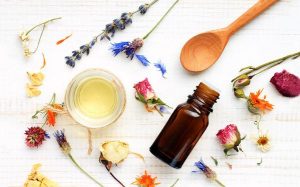
Essential oils are the oils extracted from aromatic plants and they have long played in important role in human society. One of the oldest documents ever found – the Ebers Papyrus from 1553 BC – details how to use frankincense for a variety of ailments. When archeologist Howard Carter discovered Tutankhamen’s tomb in 1933, he found in it 32 alabaster jars used to hold essential oils . They are used in religious rituals, food flavorings, aromatherapy, in household products, personal care items and in both traditional and pharmaceutical medicines.
It’s easy to get overwhelmed starting out using essential oils and building your personal collection of EO’s (essential oils), because of the sheer volume of different oils out there and the characteristics listed for each. (There are more than 90 commonly used essential oils)! Here is a guide to get you started with some of the more commonly used and more affordable essential oils which you might want to add to your “starter kit”:
1)Lavender – Lavender is an enormously popular and versatile essential oil that has the virtue of being gentle enough to use “neat” (undiluted) on healthy, unbroken skin and being safe to use (in limited quantities!) on young children. It is well-loved for its ability to promote relaxation, conquer insomnia and soothe skin conditions. Lavender will ward off moths when used in sachets in your closets and drawers and will keep insects away from you when used in a body spray. A few drops of lavender EO simmering in a pot of water with citrus peels on your stove will make a great natural air freshener. While there are a variety of lavender EOs on the market, many crafters find it handy to start with lavender 40/42, which is both quite affordable and chemically “balanced” so that the scent and properties are consistent from batch to batch.
2)Lemon – Lemon is a great anti-bacterial oil, has a refreshing, uplifting scent, and is one of the more affordable essential oils. Lemon essential oil is also incredibly helpful in homemade cleaning products. It deodorizes wonderfully and can cut grease, wax and crayon marks. A few drops of lemon EO on your cutting board will erase long-lasting odors and eliminate bacterial residue.
3)Peppermint and spearmint – These wonderful, fresh-smelling essential oils are both highly affordable and highly versatile. A cotton ball dipped in either does a great job of fighting tension headaches. Like lavender, the mint essential oils repel insects and add a fresh, clean scent to closets and drawers when used in sachets. In aromatherapy, the mint essential oils are used to soften anger, ease depression and eliminate fatigue.
4)Tea tree oil (Melaleuca) – Tea tree oil is antiviral, antibacterial and antifungal and can be very helpful in treating skin conditions such as athlete’s foot, acne and candida infections. Like both the mint and lavender essential oils, it repels insects. Tea tree oil has a very strongly medicinal, spicy smell, but it blends well with lavender to create a milder fragrance. Tea tree oil is a handy addition to sanitizing wipes due to its ability to kill a variety of viruses, fungi and bacteria and like lavender, can be used “neat” (undiluted) on healthy, unbroken skin.
5)Oregano – While oregano is more frequently lauded for its culinary abilities, it is also a great essential oil for immune support. It is a VERY powerful essential oil which must always be diluted in a carrier oil and never used “neat” (undiluted) on the skin. It makes a great disinfectant and like tea tree oil, has powerful antiviral, antibacterial and antifungal properties.
In addition to the five “starter” essential oils listed above, here are a few more items you will want to consider adding to your essential oil “starter kit”:
1)Carrier oils – These are a must-have if you plan to use essential oils for things other than homemade cleaning products, especially if you plan to apply them to skin. A carrier oil is simply a liquid vegetable oil that is used to dilute the very concentrated essential oils. Olive and grapeseed oils both make excellent and cost effective carrier oils. Fractionated coconut oil is also a good choice for a carrier oil; it is simply coconut oil which has had the long chain fatty acids removed from it. This change allows it to remain liquid at room temperature.
2)Pipettes to measure the essential oils in drops
3)Extra dark-colored (amber, cobalt blue, etc.) bottles to use in creating your own essential oil blends. The dark color of the glass is essential to help shield the oils from excess light, which destroys their light-sensitive properties
4)A good reference book on essential oils. One that is well regarded but not brand specific is “The Complete Book of Essential Oils and Aromatherapy” by Valerie Ann Worwood.


Please log in to leave a comment.